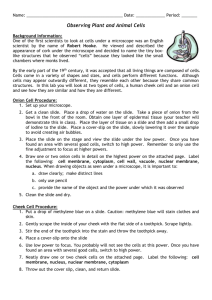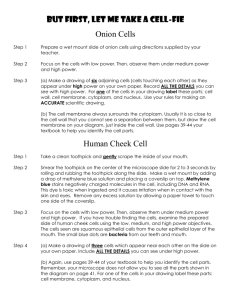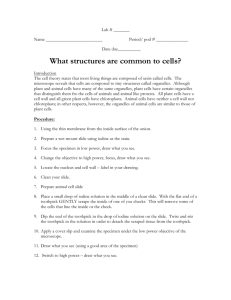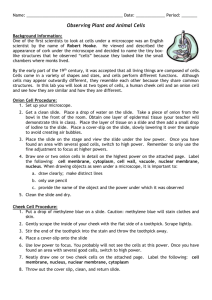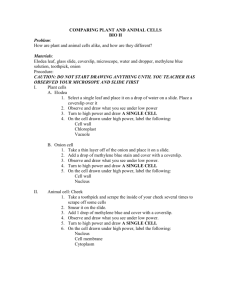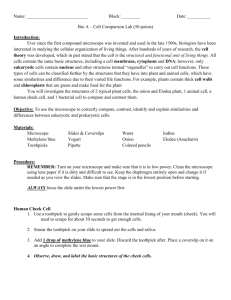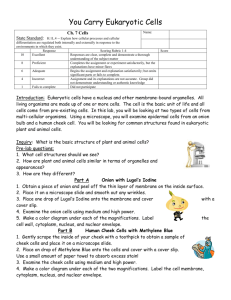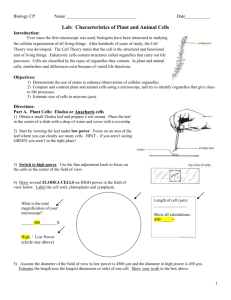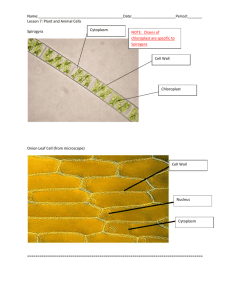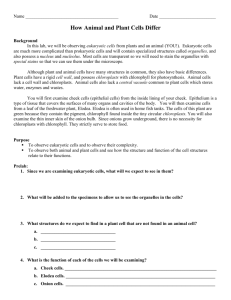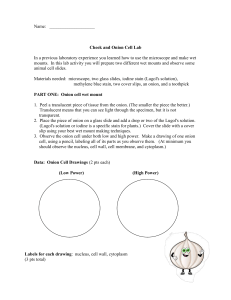Cell Lab: Cheek, Plant, Yogurt, Pond Water Microscopy
advertisement
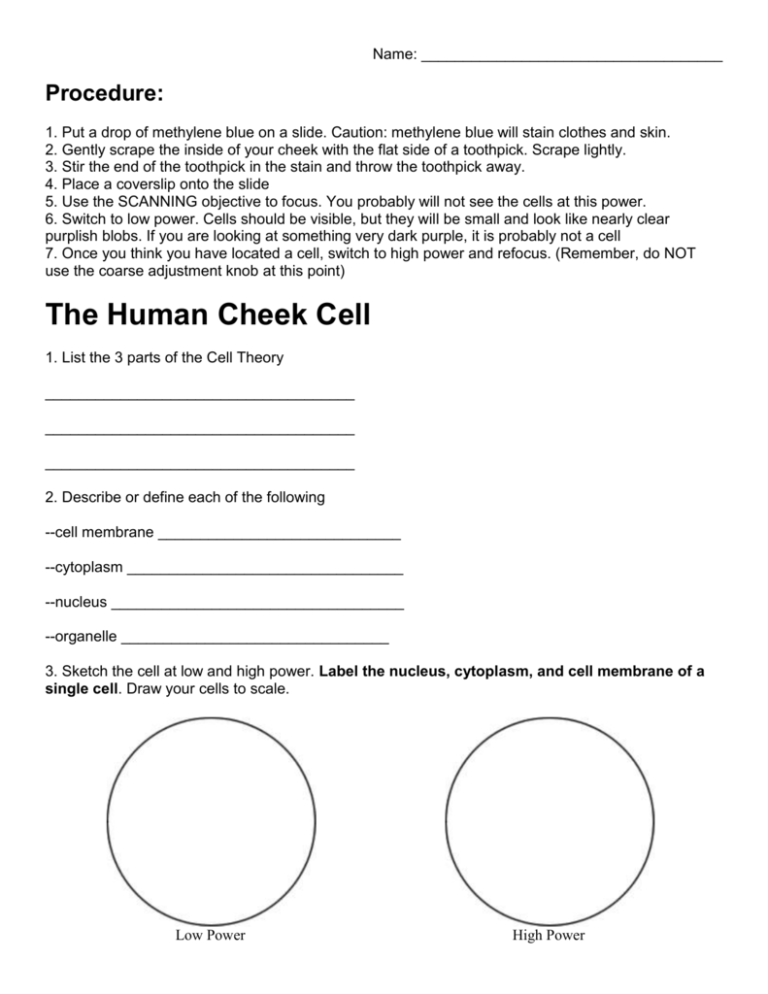
Name: ____________________________________ Procedure: 1. Put a drop of methylene blue on a slide. Caution: methylene blue will stain clothes and skin. 2. Gently scrape the inside of your cheek with the flat side of a toothpick. Scrape lightly. 3. Stir the end of the toothpick in the stain and throw the toothpick away. 4. Place a coverslip onto the slide 5. Use the SCANNING objective to focus. You probably will not see the cells at this power. 6. Switch to low power. Cells should be visible, but they will be small and look like nearly clear purplish blobs. If you are looking at something very dark purple, it is probably not a cell 7. Once you think you have located a cell, switch to high power and refocus. (Remember, do NOT use the coarse adjustment knob at this point) The Human Cheek Cell 1. List the 3 parts of the Cell Theory _____________________________________ _____________________________________ _____________________________________ 2. Describe or define each of the following --cell membrane _____________________________ --cytoplasm _________________________________ --nucleus ___________________________________ --organelle ________________________________ 3. Sketch the cell at low and high power. Label the nucleus, cytoplasm, and cell membrane of a single cell. Draw your cells to scale. Low Power High Power 5. Why is methylene blue necessary? 6. The light microscope used in the lab is not powerful enough to view other organelles in the cheek cell. What parts of the cell were visible. 6. List 2 organelles that were NOT visible but should have been in the cheek cell. 7. Is the cheek cell a eukaryote or prokaryote? How do you know? 8. Keeping in mind that the mouth is the first site of chemical digestion in a human. Your saliva starts the process of breaking down the food you eat. Keeping this in mind, what organelle do you think would be numerous inside the cells of your mouth? Plant Cell Purpose: Students will observe plant cells using a light microscope. Two cells will be observed, one from the skin of an onion, and the other from a leaf. Students will compare both types of cells. Prelab Questions 1. What is the function of chloroplasts? 2. Name two structures found in plant cells but not animal cells. 3. Name three structures found in plant cells AND in animal cells. 4. What structure surrounds the cell membrane (in plants) and gives the cell support. Part A - Onion Cells Obtain a slide and place a thin piece of onion onto the slide. Then add a drop of iodine to stain the cells for viewing. Finally add a coverslip to the slide. Do not press the coverslip. View under the microscope and sketch the cells at each magnification. Label the cells as they appear under high power. Part B – Leaf Cells Create a slide for to view the leaf cells. As the slide warms from the light of the microscope, you may see the chloroplasts moving, a process called cytoplasmic streaming. Post Lab Questions 1. Describe the shape and the location of chloroplasts. 2. Why were no chloroplasts found in the onion cells? (hint: think about where you find onions) 3. Which type of cell was smaller - the onion cells or the leaf cells? 4. Fill out the Venn Diagram below to show the differences and similarities between the onion cells and the leaf cells. Yogurt Sample 1. What types of cells were found in the yogurt sample? 2. Did you observe any movement? 3. Draw what was observed: Pond Water Sample 1. Create a slide from the pond water. 2. What types of organisms did you see? 3. Are the organisms prokaryotes or eukaryotes? 4. Draw what was observed: The Human Cheek Cell KEY 1. List the 3 parts of the Cell Theory ______all living things are made of cells_________ ______cells can only come from other cells______ ______cells are the basic unit of structure and function____ 2. Describe or define each of the following --cell membrane ______outer boundary of the cell_______ --cytoplasm ___fluid within the cell__________ --nucleus _____control center of the cell_________________ --organelle ____cell structure that has a specific function________ 3. Sketch the cell at low and high power. Label the nucleus, cytoplasm, and cell membrane of a single cell. Draw your cells to scale. Low power should have cells that are fairly small within the viewing field, at high power a cheek cell will take up about half of the viewing field. 5. Why is methylene blue necessary? cells are transparent 6. The light microscope used in the lab is not powerful enough to view other organelles in the cheek cell. What parts of the cell were visible. nucleus, cell membrane 6. List 2 organelles that were NOT visible but should have been in the cheek cell. mitochondria, lysosome, endoplasmic reticulum 7. Is the cheek cell a eukaryote or prokaryote? How do you know? eukaryote, has a nucleus 8. Keeping in mind that the mouth is the first site of chemical digestion in a human. Your saliva starts the process of breaking down the food you eat. Keeping this in mind, what organelle do you think would be numerous inside the cells of your mouth? lysosomes Plant Cell Lab Key Original Document: Plant Cell Lab Purpose: Students will observe plant cells using a light microscope. Two cells will be observed, one from the skin of an onion, and the other from a common aquarium water plant (anacharis). Students will compare both types of cells. See also: Plant Cell Lab Makeup, which utilizes web resources to complete lab guide. Prelab Questions 1. What is the function of chloroplasts? capture sunlight and convert into chemical energy; photosynthesis 2. Name two structures found in plant cells but not animal cells. chloroplasts, cell wall, central vacuole 3. Name three structures found in plant cells AND in animal cells. cell membrane, nucleus, cytoplasm, mitochondria, endoplasmic reticulum, ribosome, golgi apparatus 4. What structure surrounds the cell membrane (in plants) and gives the cell support. cell wall Part A - Onion Cells Obtain a prepared slide of onion cells or prepare one yourself. View under the microscope and sketch the cells at each magnification. Label the cells as they appear under high power. Images will vary based on student skill and attention to detail. View my microscopy set at flickr for real photos of onion and eloda cells. Part B - Elodea Cells View a prepared slide of elodea (anacharis), which is an aquarium plant. As the slide warms from the light of the microscope, you may see the chloroplasts moving, a process called cytoplasmic streaming. Images will vary based on student skill and attention to detail. View my microscopy set at flickr for real photos of onion and eloda cells. Post Lab Questions 1. Describe the shape and the location of chloroplasts. Small green circles that circle around the vacuole 2. Why were no chloroplasts found in the onion cells? (hint: think about where you find onions) Onions are root plants, they do not photosynthesize 3. Which type of cell was smaller - the onion cells or the elodea cells? elodea was smaller 4. Fill out theVenn Diagram below to show the differences and similarities between the onion cells and the elodea cells. Answers vary, sample:

